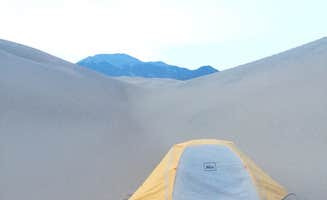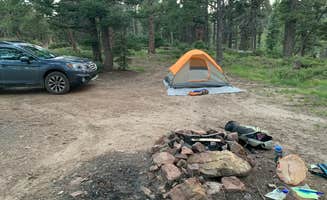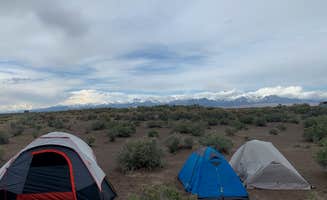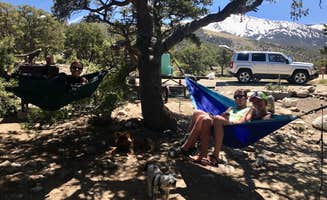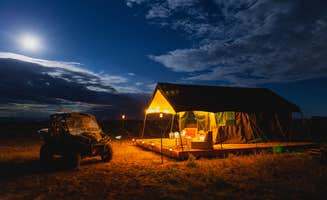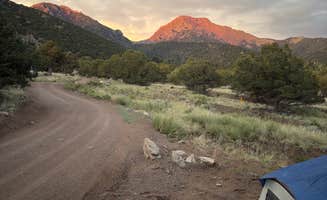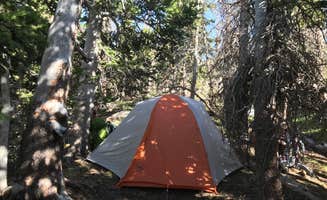Camping in the Great Sand Dunes National Park & Preserve sits at an 8,200-foot elevation where desert sands meet alpine forests, creating temperature swings of 30-40 degrees between day and night. The San Luis Valley receives less than 10 inches of annual rainfall, contributing to the arid environment where monsoon thunderstorms frequently form over the mountains in July and August. Cellular reception varies greatly across camping areas, with high points near Mt. Blanca offering better connectivity than lower valley locations.
What to do
Hike to Zapata Falls: 3 miles round trip from the campground at Zapata Falls to view the 30-foot waterfall hidden inside a mountain crevice. "[The waterfall] is secreted inside a mountain crevase and you must walk the frigid mountain water in. Yes, your feet will go numb...but it is worth it...a 30ft cascade at 9400 foot elevation," writes Dave V. about Pinon Flats Campground.
Night sky photography: Best from April to October when skies are clearest. "Dark skies there. You can see the Milky Way with the naked eye," reports a camper at Sacred White Shell Mountain. This dispersed camping area offers unobstructed views with minimal light pollution for astrophotography.
Sand sledding: Rent equipment before entering the park to save time and money. "It was nice to find a campsite with a shower after 2 nights without one... You can rent sand boards and sleds here if the weather is right," explains Chris P. at Sand Dunes Swimming Pool & RV Park, which offers rentals for $20.
What campers like
Natural hot springs: Open year-round with discounts for overnight campers. "The Hot springs consist of a large outdoor pool and a couple of smaller pools. It's $15 to soak or half price if you camp there. The Greenhouse pool is 21+ for an additional $3," notes Andrew B. about Sand Dunes Recreation, offering a relaxing contrast to hiking the dunes.
Dispersed camping solitude: Drive 10+ miles from main roads for truly remote sites. "The area can get very windy so we were unable to make a fire one of the nights... The dogs on site kept our fur girl entertained and made it feel safe," shares Teresa D. about her stay at Rabbit Hole Ranch, a dispersed-style campground with established fire pits.
Early morning wildlife viewing: Best before 8am when temperatures are cooler and animals are active. "We woke up early and hiked along the wetlands nature trails, catching an amazing sunrise with panoramic views over the lake, Great Sand Dunes and surrounding mountains," reports Isabelle K. about Mosca Campground.
What you should know
Fire restrictions vary by location: Check current status before arrival. "We were unable to use the fire pit due to fire bans that were in effect in this area," notes a camper at Mosca Campground, which requires all visitors 16 and over to have a State Wildlife Area pass ($10 per person).
Mosquitoes are worst near water sources: Bring plenty of repellent, especially in June-August. "July was mosquito madness. Honestly I am from the country and can deal with bugs, but being dived bombed by 30 mosquitos is intense," warns Sarah B. about camping near Medano Creek.
Wind conditions can change rapidly: Secure tents properly with extra stakes. "It was windy several times when we were there, and it will blow sand and dust in the RV. Nothing too bad but be aware," explains a camper at Sacred White Shell Mountain, where afternoon wind gusts frequently exceed 30 mph.
Tips for camping with families
Choose sites with shade structures: Essential for midday sun protection. "The sites were decently spaced apart and each offered electrical hookups, sheltered picnic tables and fire pits with grills," notes a visitor to Mosca Campground, where covered picnic tables provide relief from intense summer sun.
Visit Medano Creek during peak flow: May through early June offers best water play. "We camped here mid summer. We picked a perfect time because it rained in the afternoons which cooled things down nicely and kept the sand firm in the morning while we hiked," shares Tom C. about Pinon Flats Campground.
Try backcountry camping with older children: Permits required for unique dune camping. "The journey begins with a hike deep into the park's rugged terrain, where you're surrounded by towering sand dunes, alpine forests, and sweeping views of the Sangre de Cristo Mountains," explains Paulina B. about The Dunefield, where you can camp directly on the dunes with a free permit.
Tips from RVers
Lower tire pressure for sand driving: Reduce to 20-30 psi for Medano Pass. "I aired down to 50 from 65, LOL. I figured I'd make it on 35's 12.5" wide, but I can definitely see where as the Sand gets softer I would have gone down to the recommended 20psi," advises Jason L. about Medano Pass Primitive Road, which requires high-clearance 4WD vehicles.
Stock up on supplies in Alamosa: 20-30 minutes from most camping areas. "Alamosa is 20 miles away with a Walmart and anything else you might need," mentions Butch K. about services near camping areas.
Be aware of hot water at certain campgrounds: Some have thermal water sources. "One funny thing is if you have an rv and hook up to the water, it is fed from the hot springs so the water is always very warm. Didn't get to test out our hot water heater at this location!" shares Heidi S. about the unique plumbing at Sand Dunes Recreation.


